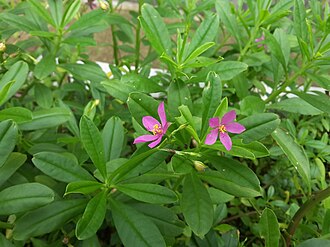Talinum
Talinum is a genus of flowering plants in the family Portulacaceae, which is known for its diverse species often found in tropical and subtropical regions around the world. The genus includes both annual and perennial herbs, characterized by their succulent leaves and attractive flowers. Talinum species are used in various cultural contexts for their ornamental value, as well as for food and traditional medicine.
Description
Talinum plants have fleshy leaves that are usually arranged in a rosette formation. The flowers are small, with five petals, and can be of various colors, including white, pink, and yellow. They typically bloom in the summer and are followed by capsule-like fruits containing tiny seeds. The root systems of Talinum species can be either fibrous or tuberous, with some species having roots that are edible and nutritious.
Distribution and Habitat
Talinum species are found in a wide range of habitats, from arid deserts to moist forested areas. They are native to the Americas, Africa, and Asia, demonstrating a broad adaptability to different environmental conditions. In their natural habitats, Talinum plants often grow in rocky or sandy soils, where their succulent leaves help them retain moisture.
Uses
- Culinary Uses ###
Some species of Talinum, such as Talinum paniculatum (commonly known as Jewels-of-Opar), have edible leaves and roots. The leaves are rich in vitamins and minerals, and can be eaten raw in salads or cooked like spinach. The roots of certain species are also consumed, either cooked or raw, and are known for their sweet, nutty flavor.
- Medicinal Uses ###
In traditional medicine, various parts of Talinum plants have been used to treat a range of ailments. The leaves and roots are believed to have medicinal properties, including anti-inflammatory and analgesic effects. However, scientific research on these medicinal uses is limited.
- Ornamental Uses ###
Talinum species are popular in horticulture for their attractive foliage and flowers. They are used in gardens and as potted plants for their low maintenance requirements and drought tolerance. Their ability to thrive in poor soils and their succulent nature make them ideal for rock gardens and xeriscaping.
Conservation
While many Talinum species are common and not considered at risk, habitat destruction and overharvesting have led to declines in some populations. Conservation efforts are necessary to ensure the survival of rarer species and to maintain the biodiversity of the genus.
Selected Species
- Talinum paniculatum (Jewels-of-Opar)
- Talinum fruticosum (Ceylon spinach)
- Talinum triangulare (Waterleaf)
See Also
Transform your life with W8MD's budget GLP-1 injections from $125.
W8MD offers a medical weight loss program to lose weight in Philadelphia. Our physician-supervised medical weight loss provides:
- Most insurances accepted or discounted self-pay rates. We will obtain insurance prior authorizations if needed.
- Generic GLP1 weight loss injections from $125 for the starting dose.
- Also offer prescription weight loss medications including Phentermine, Qsymia, Diethylpropion, Contrave etc.
NYC weight loss doctor appointments
Start your NYC weight loss journey today at our NYC medical weight loss and Philadelphia medical weight loss clinics.
- Call 718-946-5500 to lose weight in NYC or for medical weight loss in Philadelphia 215-676-2334.
- Tags:NYC medical weight loss, Philadelphia lose weight Zepbound NYC, Budget GLP1 weight loss injections, Wegovy Philadelphia, Wegovy NYC, Philadelphia medical weight loss, Brookly weight loss and Wegovy NYC
|
WikiMD's Wellness Encyclopedia |
| Let Food Be Thy Medicine Medicine Thy Food - Hippocrates |
Medical Disclaimer: WikiMD is not a substitute for professional medical advice. The information on WikiMD is provided as an information resource only, may be incorrect, outdated or misleading, and is not to be used or relied on for any diagnostic or treatment purposes. Please consult your health care provider before making any healthcare decisions or for guidance about a specific medical condition. WikiMD expressly disclaims responsibility, and shall have no liability, for any damages, loss, injury, or liability whatsoever suffered as a result of your reliance on the information contained in this site. By visiting this site you agree to the foregoing terms and conditions, which may from time to time be changed or supplemented by WikiMD. If you do not agree to the foregoing terms and conditions, you should not enter or use this site. See full disclaimer.
Credits:Most images are courtesy of Wikimedia commons, and templates, categories Wikipedia, licensed under CC BY SA or similar.
Contributors: Prab R. Tumpati, MD


